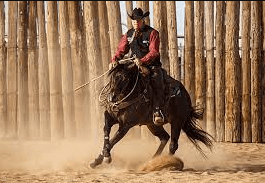What Is The Scoring System In Reining?

Reining is a competitive equestrian sport that showcases the athletic abilities and precision of both horse and rider. In order to evaluate the performances, a scoring system has been established which takes into account various factors such as maneuver execution, finesse, horse willingness and responsiveness, and rider-horse harmony. This scoring system provides an objective measure of the quality of each performance, ensuring fairness in competition.
When it comes to maneuver execution, judges assess how accurately and precisely each movement is performed by the horse. The more precise the execution, the higher the score will be.
Finesse plays a crucial role as well, with judges evaluating the smoothness and fluidity exhibited throughout the entire performance. A high degree of finesse demonstrates not only technical proficiency but also an understanding between horse and rider.
Another important aspect considered in reining scoring is horse willingness and responsiveness. Judges observe whether or not the horse willingly performs each maneuver with enthusiasm and promptness. The level of responsiveness to cues from the rider greatly affects the overall score, as it reflects both trust between horse and rider and their ability to work together harmoniously.
Lastly, rider-horse harmony is assessed based on how seamlessly they communicate with one another during their performance. The ability to anticipate each other’s movements creates a sense of unity that enhances both technical execution and aesthetic appeal.
In conclusion, reining scoring system evaluates various aspects including maneuver execution, finesse, horse willingness and responsiveness, as well as rider-horse harmony. By assessing these factors objectively, judges ensure fair competition while showcasing the athleticism and artistry inherent in this captivating equestrian sport.
Maneuver Execution and Finesse
Maneuver execution and finesse are key components in the scoring system of reining, as they contribute to the overall evaluation of a rider’s performance.
Precision and accuracy play a crucial role in reining, as riders are expected to execute each maneuver with utmost precision, following a predetermined pattern.
Judges closely observe the horse-rider combination and assess their ability to perform complex movements such as spins, sliding stops, and lead changes with accuracy.
The degree of difficulty also factors into the scoring system, as more challenging maneuvers require greater skill and control from the rider.
A high level of finesse is necessary for seamlessly transitioning between different maneuvers while maintaining proper form and balance.
By evaluating these aspects, judges can determine the proficiency of the rider in executing maneuvers with precision and finesse, ultimately influencing their final score.
Horse Willingness and Responsiveness
Exhibiting a remarkable display of harmony and synchronization, the equine partner’s eagerness and promptness in response to subtle cues from the rider contribute to the overall impression of finesse and precision in reining.
The horse’s willingness and responsiveness are crucial elements that are assessed in the scoring system of reining.
Through various horse training techniques, riders aim to establish effective communication cues with their horses, enabling them to execute maneuvers seamlessly.
This requires a deep understanding of the horse’s body language and psychology, allowing for clear and precise signals to be transmitted between rider and horse.
The level of trust and partnership developed between the two is evident in the fluidity of their movements, as they effortlessly navigate intricate patterns with grace.
It is this level of connection that captivates spectators, evoking a sense of awe and admiration for both horse and rider.
Rider-Horse Harmony
The seamless coordination and unity between rider and horse showcased in reining competitions highlight the remarkable harmony achieved through effective communication cues and a deep understanding of the equine partner’s body language and psychology.
In order to achieve this level of harmony, riders must establish a balance and communication with their horses, ensuring that they are able to communicate their cues effectively without causing any confusion or resistance.
Trust is also a crucial component in rider-horse harmony, as it allows the horse to feel comfortable and confident in following the rider’s commands. This trust is built through consistent training, positive reinforcement, and the development of a strong partnership between horse and rider.
Overall, achieving rider-horse harmony requires not only technical skill but also an empathetic understanding of the horse’s needs and abilities.
Frequently Asked Questions
How are reining horses trained to perform the maneuvers with such precision and finesse?
Reining horse training focuses on developing precision and finesse in performing maneuvers. The horses undergo extensive training, which includes desensitization to various stimuli and repetitive practice of specific movements. This level of training ensures the horse’s ability to execute intricate maneuvers with grace and accuracy.
What are the most common penalties or fines that riders receive during a reining competition?
Common penalties/fines in reining include the use of unauthorized equipment, excessive or incorrect cues, and failure to perform required maneuvers accurately. The scoring system in reining assesses each maneuver individually, with deductions for faults and errors.
Are there any specific cues or signals that riders use to communicate with their horses during a reining pattern?
Specific cues and signals are used by riders to communicate with their horses during a reining pattern. These cues include leg pressure, rein aids, body position, and voice commands. Effective communication is crucial in guiding the horse through the desired maneuvers.
How do judges determine the level of willingness and responsiveness of a reining horse during a competition?
Judges determine the level of willingness and responsiveness in reining horses through a scoring system. They assess factors such as promptness, precision, and smoothness of movements. The horse’s ability to execute cues effectively is crucial for a high score.
Is there a specific criteria or standard that judges use to assess the level of harmony between the rider and the horse in reining?
Judges in reining use specific scoring criteria and judging standards to assess the level of harmony between the rider and the horse. These criteria evaluate elements such as responsiveness, willingness, and communication, ensuring an objective assessment of the partnership during competition.
Conclusion
In conclusion, the scoring system in reining is a complex and intricate process that evaluates various aspects of maneuver execution, horse willingness, responsiveness, and rider-horse harmony.
Each element is carefully assessed to determine the overall performance quality of the reining team. The judges pay close attention to every detail, ensuring that finesse and precision are demonstrated throughout the routine.
As the horse gracefully glides through each pattern, executing precise spins, sliding stops, and quick turns with effortless ease, it captivates both the judges and audience alike. The finesse displayed by both horse and rider reveals their exceptional training and dedication to mastering this demanding discipline.
Furthermore, the willingness of the horse to respond promptly to its rider’s cues is crucial in achieving high scores. The harmonious partnership between horse and rider becomes evident as they seamlessly communicate through subtle movements and shifts in weight. This unity creates a mesmerizing spectacle for spectators as they witness this beautiful dance between human and equine.
The scoring system in reining truly encapsulates the essence of this sport – a perfect blend of athleticism, trust, precision, finesse, and harmony. It serves as a testament to the skillful training of both horse and rider while providing an exhilarating experience for all who witness it.
So next time you watch a reining competition unfold before your eyes, prepare yourself for an awe-inspiring display of equestrian mastery that will leave you breathless.




